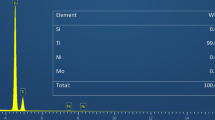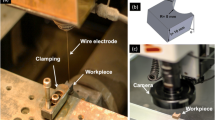Abstract
Dimensional accuracy in parts manufactured by wire EDM (WEDM) can be lost due to wire lag (where the wire electrode bends into an arc away from the machining direction). Wire lag effects are at issue when extremely narrow tolerances on curved or sharply angled geometries are desired. The feasibility of a program to modify machining G-code to compensate for wire lag at sharp corners is investigated here. Program development was informed by machining experiments. First, the effect of surface feed rate on profile accuracy was investigated. It was found that feed influences wire lag and profile accuracy. A wire lag model is demonstrated, and methods for developing modifications to incorporate both surface feed and eliminate the need for an ex situ measurement to minimize wire lag are presented. A method for relating pulse duration and voltage to each plasma discharge’s area is demonstrated. Lastly, an outline for a program that compensates for wire lag at threshold angles is shown. It is found that the developed application can predict wire lag or corner error within ±10% of the experimental value. It is also found that profile accuracy can be significantly improved using a cutback method by calculating the amount of wire lag from the modified model and modifying CNC G-codes using the developed application to apply cutbacks at designated corners.











Similar content being viewed by others
Data availability
The data will be available upon request.
Code availability
Uploaded as a supplementary file.
References
Sanchez JA, Rodil JL, Herrero A, de Lacalle LN, Lamikiz A (2007) On the influence of cutting speed limitation on the accuracy of wire-EDM corner-cutting. J Mater Process Technol 182(1-3):574–579
Puri AB, Bhattacharyya B (2003) An analysis and optimisation of the geo- metrical inaccuracy due to wire lag phenomenon in WEDM. Int J Mach Tools Manuf 43(2):151–159
Han F, Zhang J, Soichiro I (2007) Corner error simulation of rough cutting in wire EDM. Precis Eng 31(4):331–336
Puri AB, Bhattacharyya B (2003) Modelling and analysis of the wire-tool vibration in wire-cut EDM. J Mater Process Technol 141(3):295–301
Herrero, A., Azcarate, S., Rees, A., Gehringer, A., Schoth, A., and Sanchez, J. A., 2008. “Influence of force components on thin wire EDM”. Wire, pp. 5–8.
Chen Z, Zhang G (2018) Study on magnetic field distribution and electro-magnetic deformation in wire electrical discharge machining sharp corner workpiece. Int J Adv Manuf Technol 98(5-8):1913–1923
Habib S, Okada A (2016) Study on the movement of wire electrode during fine wire electrical discharge machining process. J Mater Process Technol 227(Jan):147–152
Werner A (2016) Method for enhanced accuracy in machining curvilinear profiles on wire-cut electrical discharge machines. Precis Eng 44(Apr):75–80
Conde A, Sanchez J, Plaza S, Ramos J (2016) On the influence of wire-lag on the WEDM of low-radius free-form geometries. Procedia CIRP 42:274–279
Obara, H., Kawai, T., Ohsum1, T., and Hatano, M., (2003) “Combined power and path control method to improve corner accuracy of rough cuts by wire EDM (1st report)-improvement of convex corner, convex corner R and large-radius concave corner R”.
Chen Z, Huang Y, Zhang Z, Li H, yi Ming W, Zhang G (2014) An analysis and optimization of the geometrical inaccuracy in WEDM rough corner cutting. Int J Adv Manuf Technol 74(5-8):917–929
Chen Z, Zhang Y, Zhang G, Li W (2018) Modeling and reducing work-piece corner error due to wire deflection in WEDM rough corner-cutting. J Manuf Process 36(Dec):557–564
Sanchez JA, De Lacalle LNL, Lamikiz A (2004) A computer-aided system for the optimization of the accuracy of the wire electro-discharge machining process. Int J Comput Integr Manuf 17(5):413–420
Yan MT, Huang PH (2004) Accuracy improvement of wire-EDM by real-time wire tension control. Int J Mach Tools Manuf 44(7-8):807–814
Conde A, Arriandiaga A, Sanchez JA, Portillo E, Plaza S, Cabanes I (2018) High-accuracy wire electrical discharge machining using artificial neural networks and optimization techniques. Robot Comput Integr Manuf 49:24–38
Abyar H, Abdullah A, Akbarzadeh A (2018) Analyzing wire deflection errors of WEDM process on small arced corners. J Manuf Process 36:216–223
Abyar H, Abdullah A, Akbarzadeh A (2018) Prediction algorithm for WEDM arced path errors based on spark variable gap and nonuniform spark distribution models. J Manuf Sci Eng 141(1):011011
Selvakumar G, Balasubramanian V, Lenin N (2020) Investigation on corner accuracy in wire cut EDM of AISI D3 tool steel. Int J Rapid Manuf 9(1):58–70
Kumar A, Abhishek K, Vivekananda K, Maity KP (2018) Effect of wire electrode materials on die-corner accuracy for wire electrical discharge machining (WEDM) of Inconel 718. Materials Today: Proceedings 5:12641–12648
Chakraborty S, Mitra S, Bose D (2021) Experimental investigation on enhancing die corner accuracy during powder mixed wire EDM of Ti6Al4V. Materials Today: Proceedings 38:3097–3102
Ishfaq K, Farooq MU, Anwar S, Ali MA, Ahmad S, El-Sherbeeny AM (2021) A comprehensive investigation of geometrical accuracy errors during WEDM of Al6061-7.5%SiC composite. Mater Manuf Process 36(3):362–372
Saleh M, Anwar S, El-Tamimi A (2020) Muneer Khan Mohammed, and Shafiq Ahmad, Milling microchannels in Monel 400 alloy by wire EDM: an experimental analysis. Micromachines 11:469
Mandal K, Sekh M, Bose D, Mitra S, Sarkar S (2021) Influence of dielectric conductivity on corner error in wire electrical discharge machining of Al 7075 alloy. Proc Inst Mech Eng C J Mech Eng Sci:095440622097826. https://doi.org/10.1177/0954406220978268
Ebisu T, Kawata A, Okamoto Y, Okada A, Kurihara H (2018) Influence of jet flushing on corner shape accuracy in wire EDM. Procedia CIRP 68:104–108
Yan H, Bakadiasa KD, Chen Z, Yan Z, Zhou H, Han F (2020) Attainment of high corner accuracy for thin-walled sharp-corner part by WEDM based on magnetic field-assisted method and parameter optimization. Int J Adv Manuf Technol 106:4845–4857
Chowdhury AGK, Ali MY, Banu A (2020) Analysis of corner radius in dry micro WEDM. Int J Mech Eng Robot Res 9(2):5 pages
Dauw IF, Beltrami I (1994) High-precision wire-EDM by online wire positioning control. CIRP Ann Manuf Technol 43(1):193–197
Acknowledgements
The authors would like to thank Miami University Center for Advanced Microscopy and Imaging (CAMI) for allowing to use the microscopy facilities.
Funding
The authors also would like to acknowledge the financial support from the Ohio Space Grant Consortium and Miami University Undergraduate Summer Scholars program.
Author information
Authors and Affiliations
Contributions
Experimentation, modeling, analysis, and draft preparation: Roan Kirwin. Writing and editing: Roan Kirwin, James Moller, and Muhammad P. Jahan. Supervision: Muhammad P. Jahan. Funding: Muhammad P. Jahan (PI) and Roan Kirwin (graduate fellowship)
Corresponding author
Ethics declarations
Ethics approval
All research ethics have been maintained.
Consent for publication
All authors give consents.
Competing interests
The authors declare no competing interests.
Additional information
Publisher’s note
Springer Nature remains neutral with regard to jurisdictional claims in published maps and institutional affiliations.
Supplementary information
ESM 1
(PDF 144 kb)
Rights and permissions
About this article
Cite this article
Kirwin, R.M., Moller, J.C. & Jahan, M.P. Modification and adaptation of wire lag model based on surface feed for improving accuracy in wire EDM of Ti-6Al-4V alloy. Int J Adv Manuf Technol 117, 2909–2920 (2021). https://doi.org/10.1007/s00170-021-07870-1
Received:
Accepted:
Published:
Issue Date:
DOI: https://doi.org/10.1007/s00170-021-07870-1




